Abstract
Of 253 infants with oesophageal atresia treated over an eight year period, 122 (48%) had a total of 213 other anomalies. Most commonly affected were the cardiovascular (61 cases, 29%), anorectal (30 cases, 14%), and genitourinary (29 cases, 14%) systems. The VATER (or VACTERL) association was present in 10% of cases, but occurred more often in patients who had oesophageal atresia without an associated tracheo-oesophageal fistula (3/13, 23%). The level of the associated anorectal malformation was not associated with the type of oesophageal atresia. The presence and severity of other anomalies did not influence the basic approach to treatment of the oesophageal atresia--that is, primary repair whenever possible. Despite aggressive treatment, cardiac malformations were the most common cause of death. There were five infants with the CHARGE association, two with Potter's syndrome, and two with 'SCHISIS' syndrome (cleft lip and palate, omphalocoele, and hypogenitalism).
Full text
PDF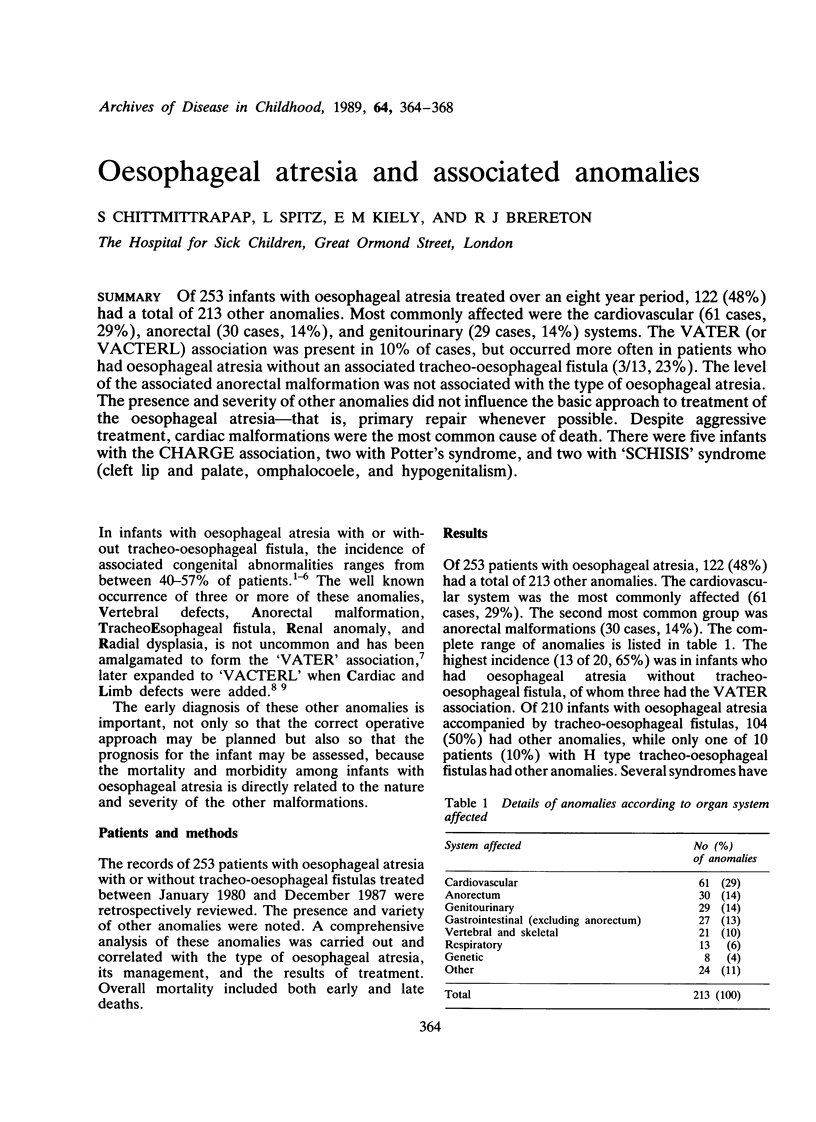
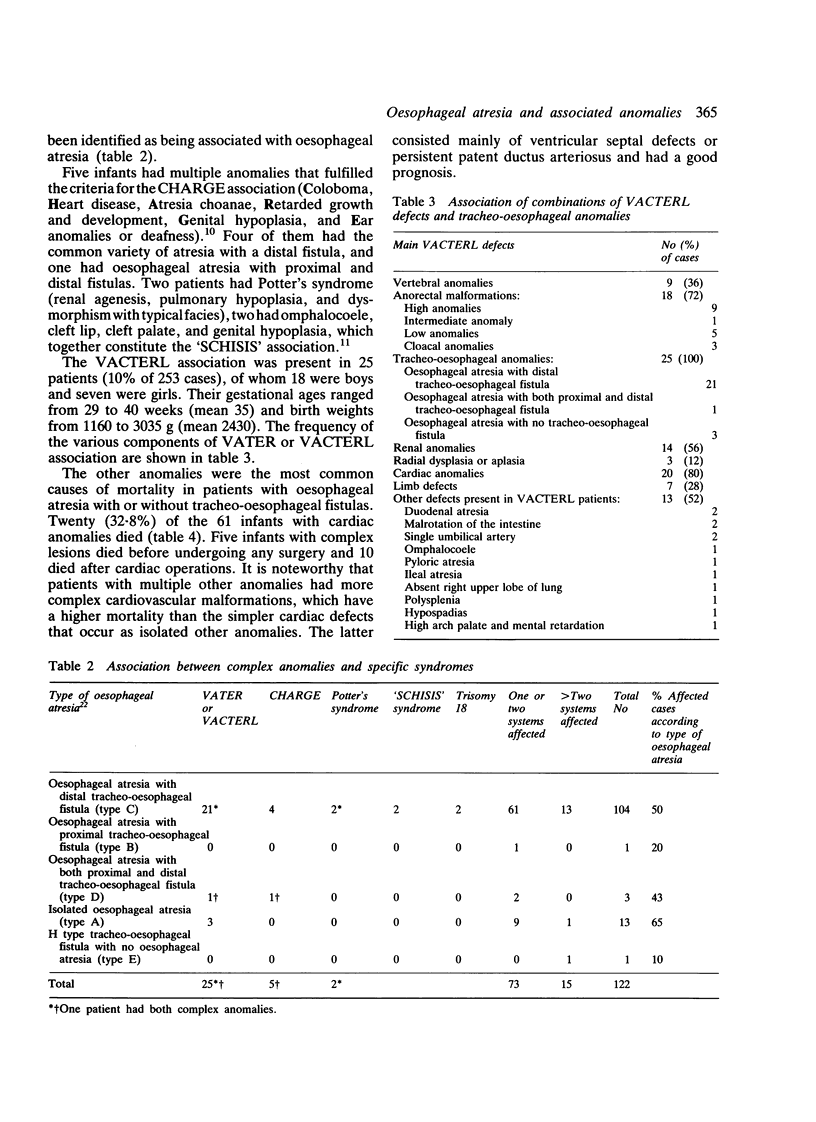
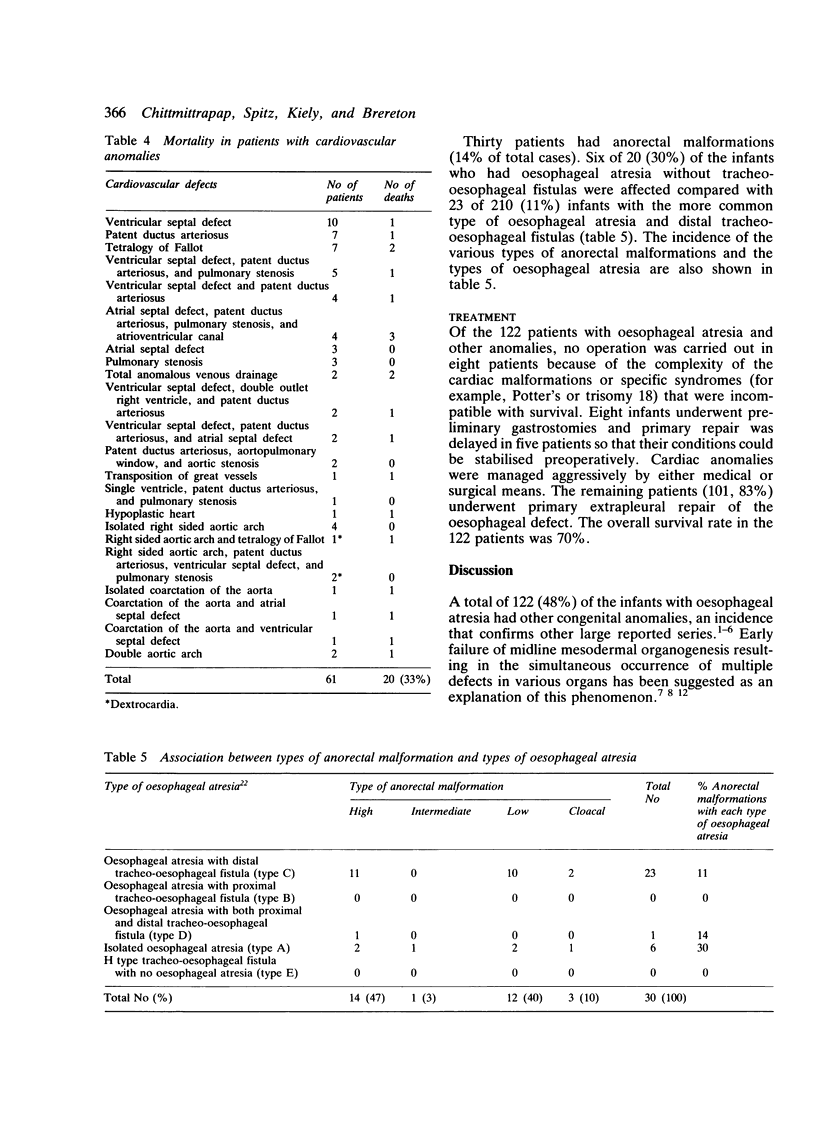
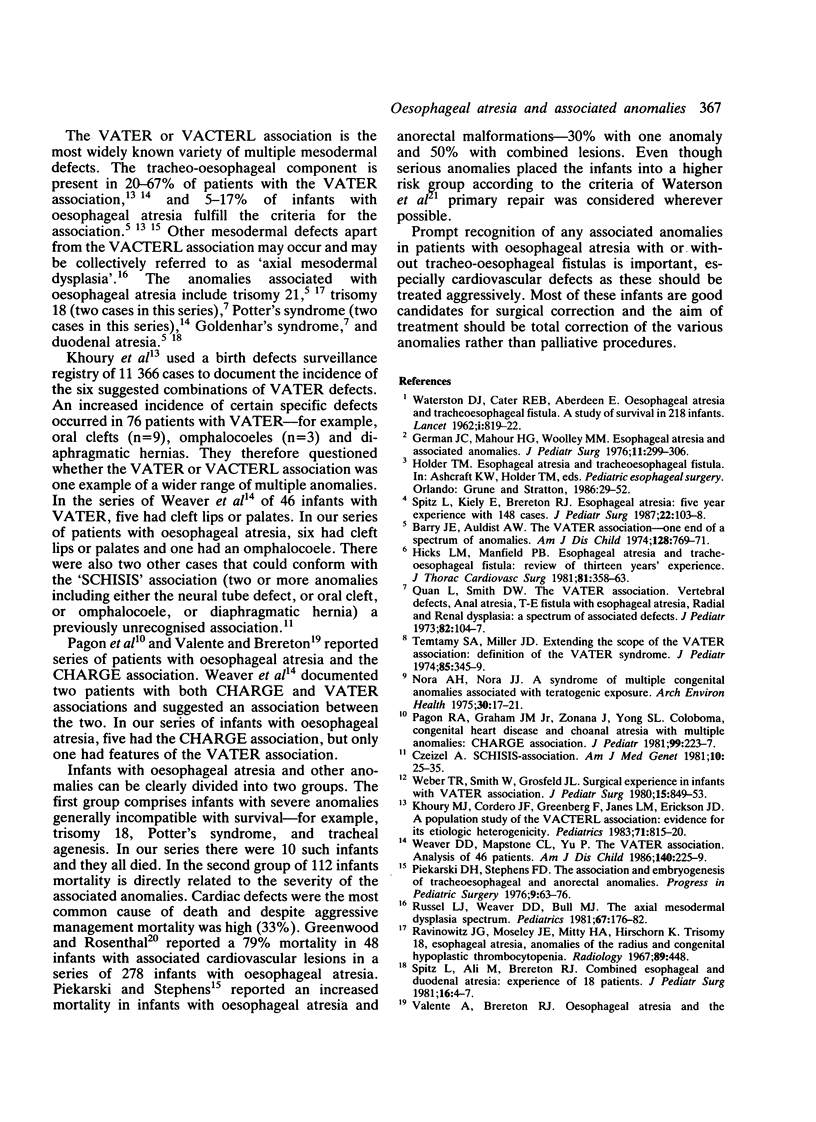
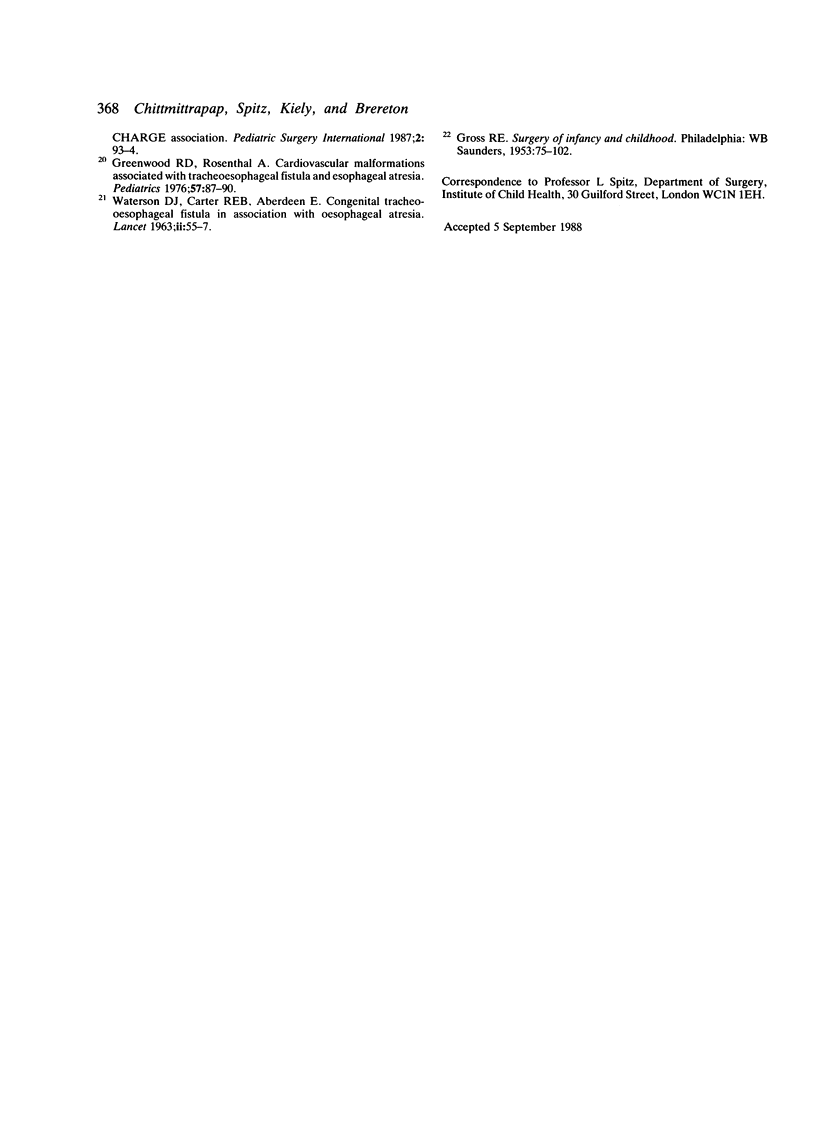
Selected References
These references are in PubMed. This may not be the complete list of references from this article.
- Barry J. E., Auldist A. W. The Vater association; one end of a spectrum of anomalies. Am J Dis Child. 1974 Dec;128(6):769–771. doi: 10.1001/archpedi.1974.02110310017003. [DOI] [PubMed] [Google Scholar]
- Czeizel A. Schisis-association. Am J Med Genet. 1981;10(1):25–35. doi: 10.1002/ajmg.1320100105. [DOI] [PubMed] [Google Scholar]
- German J. C., Mahour G. H., Woolley M. M. Esophageal atresia and associated anomalies. J Pediatr Surg. 1976 Jun;11(3):299–306. doi: 10.1016/s0022-3468(76)80182-0. [DOI] [PubMed] [Google Scholar]
- Greenwood R. D., Rosenthal A. Cardiovascular malformations associated with tracheoesophageal fistula and esophageal atresia. Pediatrics. 1976 Jan;57(1):87–91. [PubMed] [Google Scholar]
- Hicks L. M., Mansfield P. B. Esophageal atresia and tracheoesophageal fistula. Review of thirteen years' experience. J Thorac Cardiovasc Surg. 1981 Mar;81(3):358–363. [PubMed] [Google Scholar]
- Khoury M. J., Cordero J. F., Greenberg F., James L. M., Erickson J. D. A population study of the VACTERL association: evidence for its etiologic heterogeneity. Pediatrics. 1983 May;71(5):815–820. [PubMed] [Google Scholar]
- Nora A. H., Nora J. J. A syndrome of multiple congenital anomalies associated with teratogenic exposure. Arch Environ Health. 1975 Jan;30(1):17–21. doi: 10.1080/00039896.1975.10666626. [DOI] [PubMed] [Google Scholar]
- Pagon R. A., Graham J. M., Jr, Zonana J., Yong S. L. Coloboma, congenital heart disease, and choanal atresia with multiple anomalies: CHARGE association. J Pediatr. 1981 Aug;99(2):223–227. doi: 10.1016/s0022-3476(81)80454-4. [DOI] [PubMed] [Google Scholar]
- Piekarski D. H., Stephens F. D. The association and embryogenesis of tracheo-oesophageal and anorectal anomalies. Prog Pediatr Surg. 1976;9:63–76. [PubMed] [Google Scholar]
- Quan L., Smith D. W. The VATER association. Vertebral defects, Anal atresia, T-E fistula with esophageal atresia, Radial and Renal dysplasia: a spectrum of associated defects. J Pediatr. 1973 Jan;82(1):104–107. doi: 10.1016/s0022-3476(73)80024-1. [DOI] [PubMed] [Google Scholar]
- Russell L. J., Weaver D. D., Bull M. J. The axial mesodermal dysplasia spectrum. Pediatrics. 1981 Feb;67(2):176–182. [PubMed] [Google Scholar]
- Spitz L., Ali M., Brereton R. J. Combined esophageal and duodenal atresia: experience of 18 patients. J Pediatr Surg. 1981 Feb;16(1):4–7. doi: 10.1016/s0022-3468(81)80105-4. [DOI] [PubMed] [Google Scholar]
- Spitz L., Kiely E., Brereton R. J. Esophageal atresia: five year experience with 148 cases. J Pediatr Surg. 1987 Feb;22(2):103–108. doi: 10.1016/s0022-3468(87)80420-7. [DOI] [PubMed] [Google Scholar]
- Takahashi M., Abrams H. L. The accuracy of lymphangiographic diagnosis in malignant lymphoma. Radiology. 1967 Sep;89(3):448–460. doi: 10.1148/89.3.448. [DOI] [PubMed] [Google Scholar]
- Temtamy S. A., Miller J. D. Extending the scope of the VATER association: definition of the VATER syndrome. J Pediatr. 1974 Sep;85(3):345–349. doi: 10.1016/s0022-3476(74)80113-7. [DOI] [PubMed] [Google Scholar]
- WATERSTON D. J., BONHAM-CARTER R. E., ABERDEEN E. Congenital tracheo-oesophageal fistula in association with oesophageal atresia. Lancet. 1963 Jul 13;2(7298):55–57. doi: 10.1016/s0140-6736(63)90060-6. [DOI] [PubMed] [Google Scholar]
- WATERSTON D. J., CARTER R. E., ABERDEEN E. Oesophageal atresia: tracheo-oesophageal fistula. A study of survival in 218 infants. Lancet. 1962 Apr 21;1(7234):819–822. doi: 10.1016/s0140-6736(62)91837-8. [DOI] [PubMed] [Google Scholar]
- Weaver D. D., Mapstone C. L., Yu P. L. The VATER association. Analysis of 46 patients. Am J Dis Child. 1986 Mar;140(3):225–229. doi: 10.1001/archpedi.1986.02140170051027. [DOI] [PubMed] [Google Scholar]
- Weber T. R., Smith W., Grosfeld J. L. Surgical experience in infants with the VATER association. J Pediatr Surg. 1980 Dec;15(6):849–854. doi: 10.1016/s0022-3468(80)80291-0. [DOI] [PubMed] [Google Scholar]


